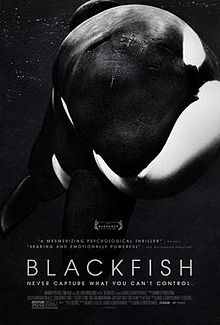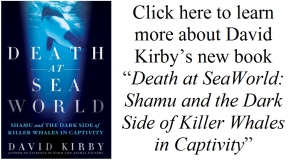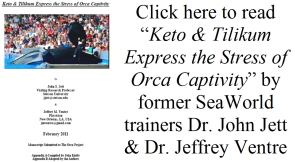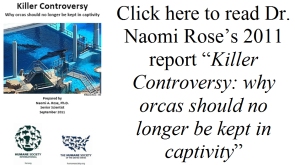New Video Shows Killer Whales in Captivity vs. in the Ocean
The Orca Project has released a new video that was created by by some incredible friends which reveals the differences between life for killer whale families in the wild and in captivity.
Although we have previously posted “A Better Way to See Orcas”, which can be seen below, this powerful video-short will change the way the public looks at orca captivity and give them the opportunity to make informed decisions about their next travel/entertainment destination:
We at The Orca Project apologize that this video is no longer available. Due to possible copyright infringement of some footage, we have regretfully removed this important and compelling video.
—
The video was prepared by Leah Lemieux, author of the book Rekindling the Waters, and Lori Marino, Ph.D., neuroscientist at Emory University, who has studied dolphins and whales for over twenty years.
This video shows the difference between life for orcas in the ocean, where they live in large, highly social family groups, and life in captivity, where they live in barren, lonely tanks. We invite everyone who watches this video to take a pledge not to buy a ticket to marine parks with captive dolphins and whales and to share this important message with family, friends and colleagues.
You can read the entire press release for this video below, or download/view/print it HERE if unable to view.
—
We’ve also included an incredible list, in conjuntion with the OrcaNetwork and friends, which shows the frequency by which the marine mammal captivity industry separates young orcas from their families.
It is known that in the wild that killer whales (orcas) are intelligent, highly social and family oriented much like humans and male orcas live an average of 30+ years and females 50+ years. Many also live well into their 80s, 90s or longer. The social bonds often keep orca families together through their entire lives.
But in captivity, at marine parks like SeaWorld, those bonds are broken, either through capture and/or transfer to other parks.
You can view “Captive Orcas Separated from their Mothers” below, or download/view/print it HERE if unable to view.
—
The financial decisions of a multi-billion dollar industry breaks apart families and disrupts the natural bonds that exists between these intelligent beings.
The above list shows how they have continuously severed those bonds.
For more information or questions you may have about cetacean captivity, this press release or the video “A Better Way to See Orcas”, please feel free to contact:
Lori Marino, Ph.D.
Emory University
lmarino@emory.edu
(404) 727-7582
And don’t forget to “Take the Pledge” HERE and make YOUR pledge not to buy a ticket to marine parks with captive dolphins and whales and to share this important message with family, friends and colleagues.
Thank you for your support!
Trackbacks
- Cetaceans are NOT Pets - Hello, Lovine.com
- Make a Splash: Free Lolita! | Animal Legal Defense Fund
- Make a Splash: Free Lolita! « STOP ANIMAL ABUSE
- SeaWorld Ponders Defeat in OSHA Ruling. Trainer Death May Alter Industry Forever « The Orca Project
- Beached « myothervoices
- Investigation Finds Hazardous Chemicals with Killer Whale Food Supply at SeaWorld « The Orca Project
- New Video Shows Killer Whales in Captivity vs. in the Ocean « The Orca Project « CyberWhaleWarrior.com








Orcas in captivity live wonderful lives, never having to worry about starvation, competition, pollution. Orcas in the wild are increasingly threatened by and DYING from water contaminants, and oil spills, and starvation (due to their prey being depleted). Furthermore, captive orcas provide a wealth of information that simply CANNOT be obtained from orcas in the wild. Releasing captive orcas into the wild isn’t successful…the orcas thrive on human stimulation and don’t integrate with their own kind well. Visiting marine parks is a way to fund continued whale research. If you encourage people to quit touring SeaWorld and other parks, research suffers because the tourism dollars dry up. It is important to understand all sides of an issue, rather than just presenting “a few” facts as a ploy on human sympathies. The marine parks and their captive orcas are an invaluable tool for advancing our understanding of these top predators. Humans who risk killer-whale interactions do it freely, of their own choice, and reap the rewards along with the risk. These risk-takers/researchers are much safer interacting in controlled park environments.
Mindy, regarding your statement that orcas in captivity live wonderful lives, please consider the following: Orcas by nature are meant to travel 100 miles a day. Contrast that with, as an example, the orca Lolita at the Miami Seaquarium, who lives in a tank 35 feet wide by 80 feet long. She is 21 feet long. This would be like a human living in a bathtub for 40 + years. Orcas primary sense is sonar, which they are unable to use in concrete tanks, so in captivity they are in sensory deprivation chambers. Orcas are highly social and family oriented beings, daughters living with their mothers and among large closeknit family units their entire lives. Family interaction is the center of their lives. Captive orcas have been torn from their families, and deprived of the family interaction so essential to their nature (in cases such as Lolita or Kiska they are the lone orca, in other cases orcas such as Tilikum they suffer regular abuse by the random orcas they were placed in a tank with as they vy for dominance.) No effort is made to simulate an orca’s natural environment in these tanks. No experience of the tidal rhythms or natural marine ecosystem, nothing to stimulate or engage them when they are not performing circus tricks under penalty of food deprivation. The water is heavily chlorinated, causing skin and eye abrasions, forcing many to have to close their eyes when underwater. They have no decisions or choices to make as they would in nature, and live lives of ceaseless monotony year after year until they die. Many captive orcas never see natural sunlight. The noise of hydraulic pumps, cheering fans and blaring music overwhelms their sensitive hearing. All the cases of violence against trainers and orca suicide are no accident; they are understandably driven to psychosis by truly torturous lives in captivity. I wouldn’t even know where to begin about Seaworld, its long history of corruption, horrors and lies, and all the blood, both animal and human, on their hands. Please watch the doumentary Lolita Dying to Entertain You on Youtube and respond with your thoughts. I mean this sincerely. Also check out The Cove to find out about Seaworld’s link to the yearly dolphin slaughter in Taiji, which is going on as we speak.
Much of what you said is dramatization rather than fact: orcas being overwhelmed, psychotic, enduring ceaseless monotony, no sunlight, no simulation, deprived of interaction, being tortured, sensory-deprived? Those things simply aren’t true, and your accusations are based only on you trying to infer human qualities onto animals in your attempt to play at human emotions. By trying to manipulate humans with sentimental opinions, you’re treating your peers in the same way the female orcas treated Tilicum. (Of course, that IS natural behavior of wild orcas too.) The only change I would like to see implemented is a longer tank…i.e an “orca run”, similar to a dog run… so the orcas could keep their fin strong. Wild orcas are dying from radiation and contaminants, and someday the captive orcas will be the only orcas left. I congratulate the employees, researchers and biologists who devote their lives to caring for and studying the captive orcas, despite constant accusations and libel heaped upon them from dramatists and people who pretend they know what an orca is “thinking”. The mortality rate of wild orcas is much higher than captive orcas, and is INCREASING as we speak, due to human-caused factors in the ocean. So, you’re barking up the wrong tree. Your energies would be better-spent focusing on the people/industries causing the extinction of wild orcas.
Sorry, are you kidding? Radiations are a secondary factor even humans are dying of cancer with radiations, then why don’t we put all humans in cage for saving them? Your argument is bullshit. 158 Orcas have died in captivity, all with sickness and suicide, orcas in wild don’t commite suicide (only in a few case like beaching) I want to see you separated from your family and confined in a small cage doing ridiculous tricks. Oh,I hope you to go to the beach and find an hungry orca 🙂
Your uncouth comments aside… what do YOU think would happen to me if I “go to the beach and find a hungry orca”? I feel very pleased that the parks are caring well for these giant animals, and are giving them the best home possible in this civilized world. “Free Willy” was essentially murdered by ignorant public demanding his release when it wasn’t safe. Hopefully you will realize that releasing the current captive-whale population would be murderous too. Besides, the whales LOVE the human attention! They live safe, secure, rewarding lives, and consistently demonstrate their happiness by their repeated interactions with humans. They perform out of pleasure. The orcas LOVE the stimulation of attention! Those of you who want to release the domestic orcas are like the losers who take their dogs out into a wilderness and release them to fend for themselves. The dogs die, alone, of starvation or injury, and in severe emotional distress. Dogs prize human companionship, and so do killer whales.
I landed here after reading David Kirby’s excellent “Death at Sea-World”. As the mother of 2 toddlers, the idea of having them taken from me just broke my heart.
When I read the title “A better way to see Orcas” I was hoping for some ideas when and where one could do that (without having to Kayak in the Johnstone Strait). I know you are not a travel agency, but I am sure this would help families to have an alternative to the entertainment parks. I am researching a bit on San Juan Islands for our next summer vacation and would be happy to share when we come back, but I’m sure there is a lot of people out there who have done the trip with (small) children already, who could offer advice. I am horrified of the prices they charge for admission at the theme parks, and (like Naomi Rose) am sure that for about the same money you can go see the whales live.
I just moved from Germany to Arizona with my family and couldn’t believe what is going on in Europe (Morgan and Loro Parque). We Europeans think of ourselves as very respectful of nature and love to self congratulate about being so much better than Americans regarding all things Ecological. I’m not so sure that’s true anymore.
We have done this! We took our toddler and older kids to San Juan Islands. We rode with one whale watch trip, but a smaller outlet that is known locally to respect the animals and will not hound them (look up James Maya and the Peregrine). The boat is small and you may likely be the only family on that trip. We also kayaked with Crystal Seas kayaking. But mostly we just stood on shore and watched these families swim by. They are close to the shore nearly every day in the summer and you can literally just sit there and watch them without in any way going into their environment. It’s amazing. Our youngest, at one, was easy to bring on the trip as the ferries are comfortable and the housing on the island are family friendly. Good luck!
I got to know Katina and Kasatka very well when they were in the public access dolphin petting pool at Sea World San Diego in 1980. They are not as dangerous as the media sensationalizes them to be. It is the poor conditions in captivity that is the problem. There is no record of a wild orca killing a human.
Will experts such as Lori be at the OSHA vs Seaworld Trial? Hoping so.. sue